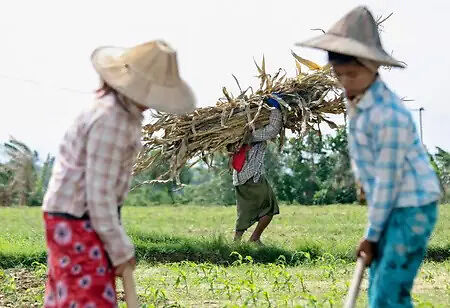
Vietnam's Sugar Industry Efforts to Restore Sugarcane Produce is Now Bearing Fruit


In recent years, the pressure on domestic sugar producers has increased as a result of the competition from imported sugar. The Vietnam Sugar & Sugarcane Association (VSSA) reports that since the start of 2023, there has been an increase in supply while retailers were sitting on a sizable surplus left over from the prior year. As a result, the market, which was already saturated and constrained by low demand, has an excess of supply.
Recently, VSSA stated that the domestic supply of the nation was assessed to have been 2.8 million tonnes last year, which was much more than the demand, which was anticipated to have been 2.1 – 2.3 million tonnes. The group anticipated that the surplus would remain as long as imported sugar kept trickling in.
There are now 126,000 fewer households growing sugarcane than there were 219,500. Since then, eleven sugar factories have shut down, resulting in a 38 percent drop in the nation's sugar production output, from 1.24 million tons to 0.77 million tons.
In the meantime, sugar imports have increased in recent years in Vietnam. Significantly, the amount of sugar imported in 2020 was 3.4 times higher than it was in 2019, with the majority of the sugar arriving from Thailand through Cambodia and Laos.
Since a number of tariffs and technical barriers were removed as the nation entered additional free trade agreements, particularly the ASEAN Trade in Goods Agreement (ATIGA) signed in 2019, which effectively removed Vietnam's import tariff for sugar starting in 2020, domestic sugar producers have struggled to compete with imported sugar, which is primarily from Thailand.
Sugarcane Farming in Decline
Due to the fact that many other crops produce higher financial yields per hectare, sugarcane has been losing favor with farmers. For instance, farmers in the Central Highlands and the Mekong Delta earn 500–800 percent more money from cassava and corn, respectively, and 1,000 – 3,000 percent more from corn.
Experts indicate that the sugar business suffered as a result of the mistreatment of sugarcane farmers, its primary suppliers.
Farmers received the smallest portion of the pie, accounting for only 11 percent of the overall profit generated by the supply chain as opposed to 44 percent for sugar manufacturers and 45 percent for wholesalers. The situation was made worse by reports of anomalies in the supply agreements between sugar companies and farmers, which led to a breakdown of trust between the parties and an unreliable supply.
Despite swings in exchange rates, the lack of raw cane has compelled many businesses to import raw sugar.
Prior to the implementation of trade remedies for sugar imported from ASEAN nations, the domestic sugar price in the third quarter of 2022 climbed by roughly 10–14 percent. Yet, according to analysts, the domestic supply of sugar can only satisfy 35–40 percent of the local demand, with Vietnam importing the remaining portion.
Tough Competition from Imported Sugar Producers
Since a number of tariffs and technical barriers were removed as the nation entered additional free trade agreements, particularly the ASEAN Trade in Goods Agreement (ATIGA), which effectively removed Vietnam's import tariff for sugar starting in 2020, domestic sugar producers have struggled to compete with imported sugar, which is primarily from Thailand.
However, thanks to the successful production results and the tariff policy's effectiveness for importing sugar, the domestic sugarcane and sugar industry anticipates that output growth will continue with the 2022–23 crop. The total area supplying sugarcane is anticipated to reach 151,305 hectares in the 2022–23 crop, according to the Viet Nam Sugar Association.
Also, the implementation of trade remedies for various cane sugar products imported from Cambodia, Indonesia, Laos, Malaysia, and Myanmar within five years supports this optimistic projection.
With a total design capacity of 122,200 tonnes of sugarcane per day, only 24 sugar processing plants are anticipated to be in operation during the 2022–23 crop, which is equal to the number of factories operating during the 2021–22 season.
According to sugar processing companies, Viet Nam's sugar sector has to improve and develop the link in the sugarcane production chain in order to assure sustainable development. Additionally, experts think that transparency is required in the evaluation of the commercial cane sugar (CCS) index and the rate at which sugar impurities are removed in mills. That will benefit businesses and farmers alike.
Nonetheless, farmers have recently switched more than half of the overall sugarcane land to other crops.
As a result, the sugar sector must recover the land used for sugarcane by planting 250,000 hectares in 2025 and 300,000 hectares in 2028.
The Viet Nam Sugar Association advises the Ministry of Agriculture and Rural Development to prioritize funding for research into sugarcane varieties and the implementation of sugarcane variety projects in significant sugarcane production areas in order to attain those development goals.
Since natural disasters have an impact on sugarcane growers, it is suggested that sugarcane be added to the list of qualifying crops for insurance.
A nationwide traceability management system for sugar goods is something else the group asks the government and ministry to promote. This technology might control and spot sugar goods that were sold illegally or for profit.
It holds that to increase the efficacy of this activity, combating smuggled and fraudulent items requires the participation and collaboration of all association members.
Industry experts have long expressed concern over a dearth of powerful domestic brands and a poor distribution system for reaching customers.
Nonetheless, a number of local producers have taken the initiative to create their own networks by working with significant merchants and online marketplaces.
In comparison to the previous crop, the price of raw sugarcane climbed by roughly VN 100,000–150,000 per tonne in the 2021–22 harvest.
Due to this, more farmers started growing sugarcane, which increased the yield. Due to this, even though less sugarcane was planted, the crop still produced the same amount of sugar.

